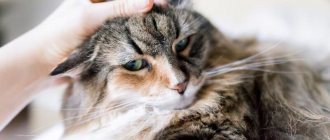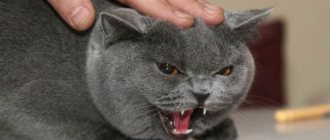Your pet is shedding - it doesn't hurt to be careful
In addition to the reasons already mentioned that provoke molting in a cat, more serious events may also occur.
Most often, owners pay attention to off-season shedding in winter, immediately starting to worry.
However, in most cases there is no reason for this, since in winter a British cat receives less vitamins, warmth and care. This is what causes the British cat to begin to actively shed.
In addition, you can name several more reasons when a pet sheds:
- stressful situations: in most cases this is associated with moving, undergoing operations or long-term illnesses;
- childbirth: in addition to the fact that the pregnancy process itself takes away strength, babies take almost all the nutrients from the mother, as a result of which she begins to shed;
- poor nutrition: cats react very sensitively to the slightest changes in their tiny bodies, so a healthy diet is very important;
- allergic reactions: most often occurs due to the British intolerance to certain types of dry food;
- hormonal surges: especially noticeable in breastfeeding women after childbirth;
- the presence of fungi and diseases.
aggressive behavior of the British
The problem is the following: my son has a cat, a lilac British one (taken from hand, without documents, so perhaps not entirely purebred). Adopted at the age of 1 month, hand-fed. Now the cat is 3.5 years old. At the age of about a year he was neutered. He eats dry Hills and likes to always have a lot of food in his bowl. He drinks water from a bucket and from the tap in the bathroom. Healthy, well-fed, does not go outside. Not vaccinated. The toilet is in a tray with wood filler, standing in the toilet. There are three people in the family (a son, his wife and a small child 2.5). The cat was always NOT tame - only his son recognized hands. Sometimes he allowed others (his wife, me, his daughter) to stroke him, but not for long. He was loyal to the child from birth, loved to sit and look at the baby, and sleep next to his crib. It was not given into the hands and is not given - it leaves or hides. The child is monitored, not allowing him to bother the cat or cause him pain. But the child is very big-booted. In the last year or so, the problem of aggression towards people has appeared. First - to strangers (friends come for tea - the cat rushes to his feet, growling, if someone wants to, say, go to the toilet). Then - the same behavior towards his wife - once he attacked her so that she locked herself in the room. Yesterday was the culmination (according to the stories, I didn’t see it myself). Only my son is at home (my wife and baby left for the summer the day before yesterday). In the evening, a neighbor came in, they were sitting in the kitchen, drinking lightly (really lightly, and only the son, the neighbor did not drink - they were celebrating the purchase of a new TV). The cat sat opposite in the corridor and hissed and purred. Then the neighbor needed to go to the toilet, the son got up from the stool to show the way - at that moment the cat rushed at his son, on his hand, and grabbed him with his claws and teeth. The son tried to remove it, taking it by the scruff of the neck with his other hand, but the cat turned around and cut his other hand. With difficulty, the son dragged him to another room, there they somehow shook him off and locked him there. At night, the son went into another room and closed the door, the cat had the whole apartment and the balcony at his disposal. This morning, when the son called and told all this, the cat was sitting under the closet, rumbling from there when the son approached. On his hands there was a bitten thumb and multiple deep scratches. Plus - shock - how did the cat attack him?! Before this, the son was the ONLY authority for the cat in the house. Now he’s thinking about what to do next with such a cat, projecting the possibility of such an attack on the child. Options - correct the behavior (how?!!), give it away, put it to sleep... (((I would be grateful for the advice, since I feel sorry for the cat. Can this behavior be corrected so as to eliminate it in the future? HOW should one behave in the event of such an attack?
British Shorthair review
I decided to get a Brittany Shorthair! A friend of mine breeds these cats! She praised this breed to me, so I took it! I chose a cat and named her Murka, affectionately Musya! I brought this fluffy 3-month-old little ball home, everyone at home was delighted with her. My husband was constantly holding her in his arms. I took a vacation to train her to the litter box, she was still a little kitten. I cuddled with her like a child! Then, as I grew up, I began to observe that our Musya “gets crazy”! You start playing with her like this: She will either bite you and kill you, or hit you with her paw so hard that you can hear a slap. In general, she has already stopped playing like a cat. She’s very willful, you can’t pet her too much, she didn’t like it. She disliked her husband so much, and she asks: Why? We are all shocked by Muska! She started hissing at him, then started scratching him. Her husband passes by her, so she will definitely scratch him. If she passes by, she will definitely hiss while looking at him. She stopped being held in her arms altogether. Her gaze became kind of angry from underneath her forehead. If the doorbell rang, she started growling like a guard dog! Then she started climbing on the table, because she’s not hungry and will climb anyway. You start to scold her verbally, so she bares her teeth and hisses. What happened in her head, I still don’t understand! Who did she take it from, she told her, she says: “I have normal cats, sweet ones! It's a shame that we didn't hurt her, but she grew up so angry! In general, we couldn’t calm her down! And they took her to their home! I was disappointed in this breed! Beautiful cats of course. BUT! I won’t call for this kind of product anymore, I don’t know how others sell this kind of stuff! And I came across such a cat! Now I have no desire to have a cat! Again you'll come across this "Girl with character"!
Why British cats
Review: British Shorthair cat breed - Beautiful and calm animals, but shed a lot
About ten years ago I had the urge to get a merle-colored British dog, and as a result, Zhuzha settled in the family. Of course, another name is written in the passport, but that doesn’t matter.
Zhuzha has experienced at least two moves and other joys of life with us, and I can recommend this breed of cat, however, some nuances need to be taken into account.
Firstly, these cats are not tame and will not sit on your lap. Zhuzha loves to be in the company of a person, but she always comes on her own. She can sit on her lap, lie at her feet, etc., but only of her own free will.
Doesn't like strangers, hisses at them.
Secondly, she sheds a lot. I periodically clean all my clothes of gray wool. We even laid specially gray laminate flooring in the new apartment to match the color of Zhuzha. Regular brushing and using a robot vacuum cleaner helps a little.
Thirdly, she is a sole owner and periodically hisses at other animals (we also have a Maine Coon and a small kitten).
We wash it once a year, it breaks out and gets scratched. It’s also difficult to give medicine, and when we cut his claws, he wriggles like a snake.
There are no problems with health yet. Only once did my kidneys have to be treated, since then we regularly give Kotervin to prevent urolithiasis, and vaccinations once a year.
Unfortunately, after sterilization (and we sterilized her quite late, at about six years old), Zhuzha became very fat. I'm trying to feed him low-calorie food, but to no avail. Now she weighs about five kilograms, no less. She, of course, tears up furniture, but she also recognizes scratching posts. But in general, the cat is quite cultured, doesn’t jump around on cabinets and tables, doesn’t interfere with sleep at night, and doesn’t grab her legs under the blanket. Another advantage is that she is silent and almost never speaks. She is also omnivorous and not picky, and is not at all capricious in matters of food, unlike the Maine Coon. She eats both cat vitamins (Brewer's Yeast) and paste for removing hair from the stomach with pleasure. There have never been any problems with the tray, except at the very beginning, and she is happy with any filler, be it clumping or silica gel. But because of the make-up, you have to buy a rather expensive Everclean. So if you like the British, I recommend it. Calm, phlegmatic and lazy creatures. They don’t require any special care if you don’t carry them around exhibitions.
Cats are perhaps the most beloved of pets. Any changes in a pet’s body, including molting, cause owners not only fear, but sometimes even panic. Especially when it comes to the British Shorthair breed.
Seasonal molting of the British: how to make the process invisible
For each breed, the molting period may differ slightly both in the time of its appearance and in the characteristics of its passage. The British Fold cat sheds twice a year - in spring and autumn. On average, the process takes place over one month, but may be delayed due to temperature changes.
If you are tired of constantly cleaning your apartment, removing hair from furniture and other similar problems, you should familiarize yourself with the basic rules of care during such a difficult period. These include the following:
- maintaining stability in the microclimate of the room, relatively equal temperature indicators;
- a caring and reverent attitude towards the animal, which will protect both you and your pet from unnecessary stressful situations;
- regular bathing using coat care shampoos;
- carefully comb the fur every day with a massage comb, perhaps using a brush with metal teeth;
- Proper and balanced nutrition, enriched with vitamins and microelements, will help your pet when shedding.
© shutterstock
The reasons for shedding in a British cat can be varied, including non-compliance with the above-mentioned rules for caring for your pet.
Why are British cats evil? (Types and causes of aggression in British cats)
Often the aggressive behavior of cats is associated with a self-defense function. Such aggression is purely reactive in nature and is a defensive reaction to anything associated with danger or pain.
There are three main types of aggression:
1. Defensive-aggressive reactions to threat i.e. aggressive behavior by another cat or person, such as when one cat is seriously threatened or attacked by another cat or when a person punishes a cat by hurting it.
2. Antisocial reactions, when a cat behaves aggressively in order to interrupt or prevent unwanted contacts with relatives or people (for example, an animal of the same color causes aggression in the cat due to a negative experience of communicating with another cat of the same color in the past. Or a certain person is associated with pain and also causes fear).
3. Aggressive reactions in situations of competition, when, for example, one cat hisses threateningly at another, in connection with some of its actions.
Active cat aggression
Aggression can also be more active or offensive in nature. In such cases, the cat initiates aggressive confrontations with another cat or person who is not a threat to it. These are attacks during play (often found in young cats). Aggression during play is also a source of so-called instrumental aggression, i.e. aggression as a means to achieve a goal.
Active aggression, unprovoked, and sometimes violent attacks seem to indicate a zero tolerance for the presence of another cat. This type of aggression is observed mainly when a cat attacks a new cat that has recently appeared in the house, or a cat that previously showed aggression, but lost its position due to certain reasons. The main function of aggression in such situations is to expel the object of aggression. Therefore, these forms of aggression are designated as territorial aggression.
Aggression between cats living in the same house
Every owner knows that a scared cat can be very dangerous. This extreme state of fear is easy to identify: the pupils are dilated, the ears are flattened, the cat presses itself to the floor, retracting its head and tucking its paws, and begins to hiss and growl. Its readiness to attack is demonstrated by its flattened ears, dilated pupils, arched back and raised fur. The object of such defensive aggression may be another cat, dog or person. The cat, being an initially non-conflict creature, attacks only when an object that inspires fear comes too close to it.
Defensive aggression caused by fear and directed at people is rare, most often in cases of treating a fearful cat (treating a wound, giving medication, etc.). The cat, in this case, must be left alone until it calms down.
Event that caused fear
A sudden manifestation of dangerous aggression between two cats that previously got along well with each other is often explained by some unusual event that caused fear (association), for example, a noisy fall of an object, a slam of a door, etc., which the scared cat associates with aggression from another cat.
Conditioned reflex aggression
Mutual threats and fighting in general tend to increase fear in both cats and thus also lead to an escalation of fear-based aggression. The best measure to correct this problem is to eliminate problematic situations.
Some owners assume that cats are fighting in a struggle for leadership and, if you do not interfere with the fight, the problem will solve itself. This opinion is erroneous, because in these cases it is the prevention of any clashes and mutual threats that is decisive for the successful prevention of the problem. Feeding cats together and especially playing with them frequently will help reduce fear, as it is incompatible with eating and playing.
In particularly severe cases, one of the cats is placed in a cage for several hours every day, while the other gets the opportunity to move freely around the apartment, getting used to it and not feeling fear.
Another method can give results: cats are placed in two cages standing next to each other for several hours every day. This method is used for a long time, eventually, the fear reactions weaken, and the cats gradually learn to eat, live, play, etc., in the presence of each other without fear.
If the problem is not just a temporary phenomenon of clashes and mutual threats, it is advisable to keep cats separately.
Aggression to a negative stimulus; defensive aggression
The basis of a cat's protective behavior is not necessarily conditioned reflex fear. Even a balanced, affectionate cat can display defensive aggression in response to a negative stimulus. How else can you react to a tail pressed by a door, a heel on a paw and other horrors of living together?!!
In this case, pain may prompt the cat to react defensively. She will put out her claws or start biting. This should be remembered when young children, unsupervised by adults, are attacked by a cat while playing. For the same reason, a bite from one angry cat can cause an aggressive reaction in another cat.
There are also frequent cases of aggression caused by stroking for too long, which is unpleasant for the cat. Different cats have different attitudes towards stroking with their hands: some of them are vitally important, and they are ready to lie on their owner’s lap for hours, others tolerate it depending on their mood, patience is exhausted, cats bite the hand and jump to the floor to run away. As they say, nothing personal. These are purely individual preferences and therefore it is necessary to avoid actions that cause a negative reaction from the cat.
To do this, you need to be able to recognize signs that indicate irritation (for example, tail movement, restlessness, pinned ears).
Territorial aggression
Territorial aggression differs from defensive aggression in that the actions of the aggressor are determined not by fear, but by completely different motives. At any opportunity, a terrorist boldly pursues his opponent and attacks him.
In the case of classic territorial aggression, the aggressor does not show the slightest sign of fear before the attack and, more often than not, persistently seeks confrontation, using every opportunity to attack. This is how a new animal can be welcomed into the house. This problem usually appears between one and three years of age and can also occur in cats that previously got along well with each other.
Sometimes cats, without showing fear, attack house guests. This is an example of active aggression directed at people, which suggests some kind of defensive motivation underlying this behavior.
If, when correcting the classic form of territorial aggression (where one cat fearlessly, constantly stalks, chases and attacks an extremely fearful victim), all measures taken have not achieved results, the only reasonable solution will be to find a new owner for one of the cats.
Aggression between cats
Aggression between cats can be considered a form of active or territorial aggression. In the wild or in conditions of partial freedom, cats quite clearly demonstrate territorial behavior, often reacting aggressively to each other. When two unfamiliar cats meet, they may demonstrate ritualistic threatening postures and movements.
Their body is like a stretched bowstring, they stand opposite each other on outstretched legs, without taking their eyes off each other. At the same time, their ears are pressed back and turned back. They shake their heads, purr and, grinning, open their mouths. If one of them stops threatening the other and begins to slowly retreat, the fight may not take place.
If several conflicting cats live in the same house, you can try to apply the behavior correction methods already discussed above (for forms of defensive aggression) to them. If this does not bring a positive result, the owner can only give away one of the cats, or castrate them both. In most cases, as a result of castration, their aggression disappears, or at least weakens, in the absence of a reason for the dispute. However, their mutual intolerance may be much deeper. In this case, castration does not solve the problem. Therefore, if aggressive behavior does not stop, then no behavior correction measures will help. In this case, owners can be advised to keep only one animal in the house.
Pathophysiological aggression
Aggression in cats can be triggered by a number of pathophysiological diseases: trauma, infection, parasites, rabies, arthritis, blocked anal glands, painful lesions of the skin around the mouth, tumors, toxins and feline ischemic encephalopathy, etc. As a result of the uncomfortable state, the sick cat becomes irritable and displays defensive aggression.
Idiopathic aggression
In this case, the cat attacks family members without any apparent reason. Such aggression does not fit into any of the usual schemes of defensive or active aggression, but carried out in vet. hospital examination excludes the presence of pathophysiological disorders. In the specialized literature, such attacks, caused by unknown reasons, are called idiopathic aggression.
Rough games
If the only cat in the house is left alone for a long time, then due to its unspent energy, one can observe an excessively high playfulness of the animal. Attacks on owners during play indicate a lack of communication.
The same problems arise from rough and improper games with a cat. They can also cause the cat to attack family members, encouraging it to behave aggressively.
As a distracting maneuver, inexperienced caregivers sometimes throw toys at the cat, which only encourages the animal to continue playing and increases its desire to attack its owner. In this case, you should persistently and consistently stop such cat games in every possible way.
War with the aggressor
For any attack, the cat must be punished immediately. For example, she can be strongly scolded, sprayed with water from a water pistol or sprayer, or scared with a loud sound (clapping hands, rattles, etc.).
The distracting stimulus must be strong enough to stop the aggression instantly. At the same time, the punishment should not be too severe, otherwise the cat, frightened, will hide and remain in ambush for a long time.
For aggressive behavior, the cat should be punished immediately after the attack (i.e. within 1-2 seconds).
A very active and playful cat needs to move more, which will weaken its desire to attack its owner.
When a cat is left alone, it must have toys at its disposal that it loves to play with.
The best thing you can do to keep your cat from getting bored and to have the opportunity to express its energy is to get a few more cats!
To meet the cat's play and exercise needs, it is very helpful for the owner to set aside time for daily play with the cat.
Instrumental behavior
Sometimes cats use aggression as a kind of tool (cats use it as a tool or strategy in their pursuit of a goal).
Problems associated with begging, intrusiveness and the cat's desire to attract attention sometimes become a disaster. For example, the owner has to wake up at night and satisfy the desires of his cat. Feed her or play with her until she calms down and allows him to fall asleep. The lack of a desired reward can cause her to react negatively (for example, demanding meows).
To stop any unwanted forms of cat behavior, you need to once and for all determine for yourself who is intended for whom. The cat is for you or you are for her. And based on the decision made, build further relationships. In all cases, your coexistence should be built on mutual respect.
At the same time, having banned something once, you should continue to be consistent in your actions. Only then will the cat learn the futility of its excessive claims. You should not change your positions until the cat's behavior is completely corrected.
Recommended
For example, to correct the frequently recurring form of instrumental behavior of a cat that constantly wakes up its owner in the middle of the night, choosing him as an indispensable participant in its games, you should try the following actions:
Leave it outside the bedroom door at night.
Under no circumstances should you open the door for her, even if she meows and tries to knock down the door.
Do not respond to the cat's complaints. (Don't talk to her or make any noise).
Most likely, during the first few nights, the cat will experience severe stress due to being expelled from the bedroom, and its behavior will worsen even more. This is fine. You just need to show more persistence than she did, and sooner or later your tormentor will calm down her claims.
After a few quiet nights, you may unthinkingly relax, imagining that your invader has finally given up trying to spend the night with you. It's an illusion! As soon as he gets into the coveted room, everything will start all over again.
In fact, the creature you abandoned will continue to try to impose its company on you for a long time, sneaking into the bedroom. Be strong! The main thing in this situation is never to give in, and then attempts will be repeated less and less over time and will stop completely when the cat is finally convinced of the futility of its intentions. However, hope dies last.
5 / 5 ( 1 voice )











